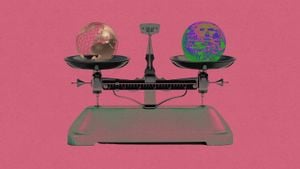NASA is facing significant challenges as the agency considers how to bring two of its astronauts, Barry "Butch" Wilmore and Sunita "Suni" Williams, back to Earth after they became stranded aboard the International Space Station (ISS). Their mission was initially intended to last just eight days, but unforeseen complications with Boeing's Starliner spacecraft have extended their stay indefinitely.
The astronauts launched to the ISS on June 5, 2024, as part of Boeing's first crewed flight of its new spacecraft. Their original task was to conduct tests and maintenance on the Starliner during their brief mission, but technical issues emerged soon after their arrival.
Thruster malfunctions and additional technical glitches were discovered during the Starliner's inaugural mission, significantly delaying their anticipated return. Reports reveal key concerns with the spacecraft's propulsion system, which have led to NASA re-evaluations on whether to risk sending the astronauts back via the Starliner or to rely on alternative methods.
During this extended period aboard the ISS, living conditions for Wilmore and Williams have been challenging. Wilmore has resorted to sleeping on the cabin floor of the Japanese Kibo module, utilizing only a sleeping bag, which he characterized as needing to “rough it,” according to his crewmate Williams.
Meanwhile, Williams has occupied one of the space station's designated sleeping quarters, known as the Crew Alternate Sleep Accommodation. The comfort level between the two astronauts starkly contrasts, amplifying their respective grievances about the extended mission caused by Boeing's capsule troubles.
NASA administrator Ken Bowersox confirmed the agency’s pressing decision to determine the astronauts' future by the end of August. He indicated the crew was doing well but noted their collective eagerness to return home, just like the rest of the agency's team.
Boeing and NASA have been faced with public scrutiny since the Starliner's issues began. Since the spacecraft's launch, there were already signs of trouble, including multiple helium leaks and propulsion difficulties, which have contributed to testing setbacks.
There were serious questions surrounding the reliability of the Starliner, with some experts openly voicing fears about risking lives should NASA choose to use it for the return flight. Former astronaut Jose Hernandez warned about potential dangers associated with sending the crew back to Earth on SpaceX's Crew Dragon, noting specific risks related to the rapid return process.
The dilemma has sparked heated discussions within NASA concerning alternative plans, including the potential for utilizing SpaceX's Crew-9 mission, which could facilitate the astronauts' return if Starliner’s issues persist. This contingency plan could see the astronauts swap spacecrafts, which would place the success of Boeing’s program on shaky ground.
Officials from NASA and Boeing have stated they are not rushing their decision-making process. They are adamant about thoroughly assessing both the performance of the Starliner and the safety of the astronauts before finalizing their course of action.
While Wilmore and Williams are managing their time aboard the ISS by assisting with various scientific tasks and experiments, they are facing challenges associated with using limited clothing supplies, resulting from the lack of laundry facilities. Primarily, they’ve adapted to their constraints, utilizing clothes intended for their short mission until new supplies finally made it to the station.
Although the astronauts face uncertain conditions during this unprecedented situation, NASA's engineers and technicians are diligently working on the ground to resolve the Starliner’s technical challenges. They aim to gather enough information, hopefully replicable to their retro future flights, so far eluding management.
NASA took the first steps to explore the issues surrounding the Starliner by proposing additional ground tests. These tests will attempt to simulate the malfunctions experienced during the astronauts’ docking with the ISS and ascertain any underlying weaknesses within the Starliner systems.
With the looming deadline of August approaching, both Wilmore and Williams can only hope for clear communication about their return plans. The deadline will resurface all queries again focusing on the NASA-Boeing partnership, emphasizing safety above everything as they grapple with public perception.
Considering the extended stay’s long-term health effects on the astronauts remains critical. Past research has shown extended missions can lead to varying impacts on human biology, and discussions about the potential risks have highlighted the necessity for human-centered research strategies during space travel.
During previous long-duration missions, like astronaut Frank Rubio's record-setting 371 days, the toll on the body has been under thorough examination. Prolonged exposures to microgravity can have severe physiological effects, prompting NASA to gather valuable data continuously.
For Wilmore and Williams, their spirits remain high, but will likely face more than just inconveniences, as they adapt to their new schedule aboard the ISS. Considering various return strategies is pivotal to ensuring the astronauts' health remains uncompromised upon their eventual return.
Despite the current chaos surrounding the Boeing capsule, both astronauts’ experience and dedication to NASA’s greater mission shine through as they continue assisting with station operations and undertaking expert tasks within the ISS. Eventually, their mission, albeit unexpected, represents both the uncertainty and incredible resilience embedded deeply within the fabric of human space exploration.
Whether the astronauts return home aboard the troubled Starliner or through SpaceX's more established method, the incident serves as a reminder of the inherent risks involved with space travel. With rapidly advancing technologies, maintaining compliance for operational safety among missions becomes all the more critical for successful space travel.
For the audience watching from Earth, keeping up with the astronauts is not just about technical fixes—it’s also about the people behind the controls and the mission's vision. The team supporting this mission work tirelessly to innovate solutions and learn valuable lessons from each setback.
NASA's decision at the end of August will mark another pivotal moment for the future of human spaceflight, demonstrating what it takes to navigate the unknown. Until then, Wilmore and Williams remain the brave front-runners representing the principles of courage and endurance as their long mission stretches on.



